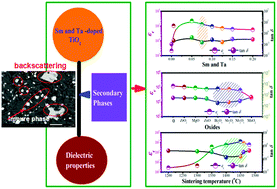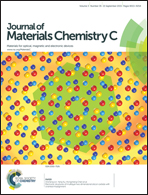Composition dependence of colossal permittivity in (Sm0.5Ta0.5)xTi1−xO2 ceramics
Abstract
In this study, colossal permittivity (CP) (104–105) is attained in the (Sm0.5Ta0.5)xTi1−xO2 ceramics, and their dielectric loss can be further decreased by doping oxides and optimizing the sintering temperatures. The effects of Sm and Ta as well as the oxides on their microstructure, dielectric properties, and stability were studied in detail. The secondary phases were induced by doping excessive Sm and Ta, and then both backscattering and EDS confirmed that excessive Sm and Ta result in the generation of secondary phases. The relationships between secondary phases and dielectric properties were established. The formation of secondary phases decreases their dielectric constant, whereas their dielectric loss can be slightly decreased through the optimization of Sm and Ta content. In addition, all the ceramics possess an improved frequency (102–106 Hz) and temperature (−150–200 °C) stability of dielectric properties. Moreover, the addition of oxides containing trivalent (Bi3+) or pentavalent (Sb5+ and Nb5+) elements can further reduce their dielectric loss. Through the results of XPS, the formation of defect-dipole clusters, e.g.,  and Ta5+Ti3+ATi (A = Ti3+/Sm3+/Ti4+), induced by Sm and Ta should be mainly responsible for enhanced dielectric properties.
and Ta5+Ti3+ATi (A = Ti3+/Sm3+/Ti4+), induced by Sm and Ta should be mainly responsible for enhanced dielectric properties.


 Please wait while we load your content...
Please wait while we load your content...